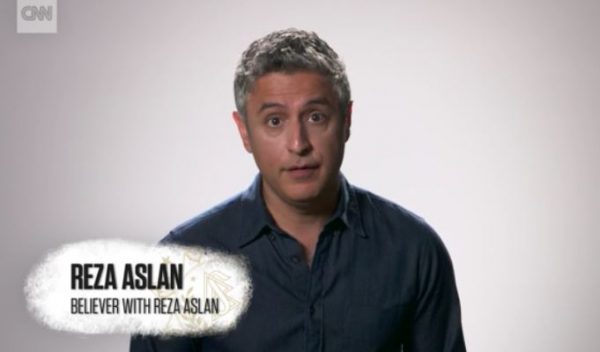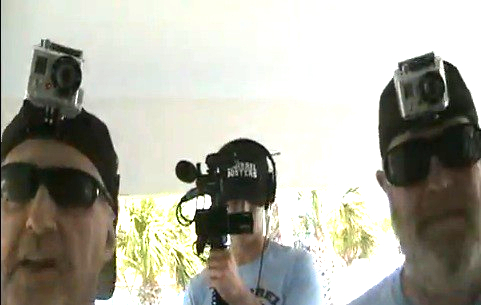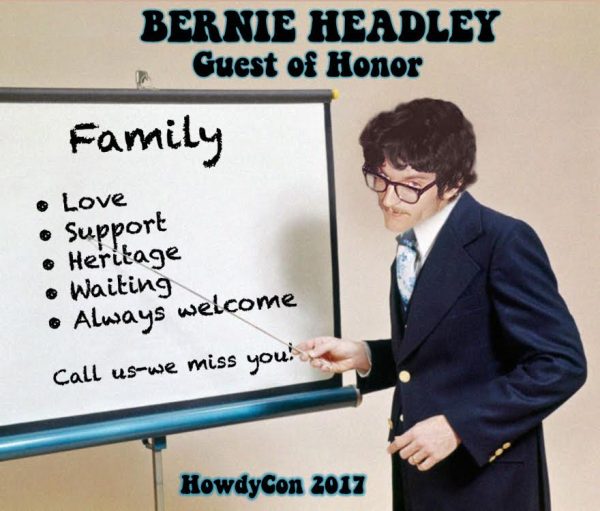We asked the producer of Believer, CNN’s series featuring University of California Riverside creative writing professor Reza Aslan, for the chance to view the episode on Scientology that’s airing this Sunday, but we haven’t been given that chance.
We knew how to contact the producer because she reached out to us a couple of years ago when they were putting the series together. At that time we had a lengthy talk with her about the current states of the Church of Scientology and independent Scientology. It was pretty clear to us then that Aslan’s own producer understood the tricky situation they had. She said she was well aware of the many controversies and alleged abuses in Scientology and she was interested in our help in getting those into the show, but she admitted that no matter what we could tell her Aslan was pretty well determined that his program would present Scientology in a positive light.
We told her that didn’t surprise us in the least. We had already seen Aslan in action, and for years he’s tried to convince people that Scientology gets a bad rap. Now, he’s getting a chance to bring his “all religions are really the same and they’re all good” message to CNN, a year after his show was actually ready to air. (CNN delayed Believer when it dawned on them just how much cash they were raking in putting candidate Trump on the air day and night.)
Despite our request, we haven’t had a chance to see Sunday’s episode. But we have seen what Aslan has said about it in interviews, and what he’s said is simply dishonest.
There was this exchange, for example, which we have a feeling will make our readers howl as much as it did us…
New York magazine: I had no idea there’s a reform movement going on in Scientology.
Aslan: I don’t think the church knows that.
The Church of Scientology, unaware that there are people outside it continuing to do Scientology on their own?
Yeah, David Miscavige is completely unaware of it. What a surprise he’s going to get if he tunes in to CNN Sunday night.
No, actually, breakaway movements and splinter groups have been happening to Scientology from the day Dianetics first hit bookshelves in 1950, for crying out loud. In fact, one of the reasons that founder L. Ron Hubbard in the 1950s and 1960s came up with such an elaborate system of control that he dubbed “ethics” was to clamp down on defectors who were always starting up their own versions of his “science of the mind.” (Scientologists to this day call what they’re doing with the E-meter an “exact science.” Labeling Scientology a “church” was first and always a dodge to avoid the tax collectors.)
In fact, you could argue that the Church of Scientology, with its “Squirrel Busters” and other well-paid private investigators and Sea Org operatives, is more aware of the activities of former church members than any other organized church. In other words, the exact opposite of what Aslan told New York magazine.
Readers of the Underground Bunker know that we have a long history of writing about “independent” Scientology, and that while we find many reasons to question the ideas of L. Ron Hubbard, we have respect for people who admire him and practice his philosophies on their own. We have often celebrated Dani and Tami Lemberger, for example, who bravely took their mission independent of the church in 2012, and have continued to operate it in the face of church harassment. (Just yesterday we wrote about their libel and fraud trial against Scientology that was recently settled.)
We’ve even visited their “Dror Center” in Haifa, which will be featured in this Sunday’s episode of Aslan’s show. We expect that the Lembergers were treated well by Aslan, and that it will be reflected in the show.
But here’s what we learned when we stopped by there last summer. After four years as an independent Scientology center, Dani told us that it really wasn’t growing much. We don’t mean this as a criticism of Dani. It’s just the truth. When he broke away from the church, he did so with about 50 members. Four years later, he says he has about 60 actively involved at the center.
We’ll repeat it so there’s no misunderstanding: We admire the Lembergers, and we think the Church of Scientology should leave them alone and allow them to study Hubbard in any way they wish. But this is not a growing movement in Haifa, or anywhere else in Israel.
Another source of independent Scientology that will be featured by Aslan, we hear, is the annual “Freezone” convention that Rey Robles puts on in Reno. And according to a news report about last year’s gathering, the attendance was about 36.
There are other ways of measuring independent Scientology, and we’ll get to that in a minute. But for now, just consider that fact — two of the places being featured in this Sunday’s episode represent about 60 and 36 people. But here’s how Aslan characterized independent Scientology in a recent interview:
“Those new versions are spreading at an unbelievable rate. It’s a weird phenomenon where Scientology as a religion is flourishing even as Scientology as a church seems to be contracting somewhat.”
Sure, Aslan has a show to sell. But his dishonesty, suggesting that there’s a massive “reform” movement spreading at an “unbelievable rate” and catching David Miscavige and the church unawares, is irresponsible, especially at a time when someone like Leah Remini is making so much progress finally reaching a large audience with what really matters — that the Church of Scientology is splitting apart families, bankrupting members with extreme fundraising, and destroying lives with its unlimited budgets for harassment and litigation.
As for independent Scientology, there is an interesting story to tell about it: For many Scientologists, going independent is a temporary refuge after leaving the church, but something that most defectors soon move away from as they ditch Hubbard and his ideas altogether: Mike Rinder and Marty Rathbun being two of the more well known examples of that. In 2010, the two of them were leading the most visible “independent” movement in decades; just a few years later, Rinder now criticizes Hubbard openly at his website, while Rathbun announced in 2013 that he was no longer a Scientologist of any kind, and now he’s acting particularly strangely as he appears to be helping the church attack its critics. Now that’s a story, but one we don’t expect Aslan to go near.
Instead, Aslan is going to try to convince us that Scientology isn’t as weird as we’ve all heard. Here are the bullet points he uses to describe its beliefs in a short teaser video CNN put out last week:
— We are eternal souls trapped within bodies
— We gather trauma throughout past lives
— Trauma is cleared through a process called “auditing”
Well, those descriptions are basically true of Scientology. But as long as he’s brought it up, we have a feeling that these are some of the things he’s not going to discuss as he tries to sell Scientology as a reasonable activity…
— We are eternal souls trapped within bodies: We are actually “thetans,” Hubbard proposed, who are quadrillions of years old. It was some super-powerful thetans who, out of boredom, imagined the physical universe into creation some 4 quadrillion years ago. The pursuit of Scientology is to “remember” our trillions of years of existence so that we can regain those godlike powers and create universes of our own. And it was a 1930s pulp fiction writer who somehow discovered the “scientific” processes to give us those superhuman abilities.
— We gather trauma throughout past lives: In fact, in Dianetics, Hubbard proposes that we begin gathering memories of trauma as egg, sperm, and zygote, and it’s those experiences in the womb that are the most powerful ones and that Dianetics processing was developed to handle. Also, traumas from past lives, even if millions of years old, can be quite literal and restimulative. Vivian Kubrick, for example, was convinced through Scientology auditing that back pain she suffered in her current lifetime was actually left over from an injury tens of thousands of years ago. Hubbard, meanwhile, said that we can re-experience in our jaw muscles what we as thetans went through as we inhabited ocean clams hundreds of millions of years ago. Aslan will probably also not mention that Hubbard, in order to illustrate how past lives worked, described his many lifetimes spent as a race car driver on Earth some 40,000 years ago, racing on a track booby-trapped with atomic bombs.
— Trauma is cleared through a process called “auditing”: Of course you’re going to feel better after you sit down with a friend and talk about difficulties you’ve had in your past, and we never hesitate to point out why this basic activity in auditing leads some people to believe it’s a benign activity. But will Aslan describe how incredibly repetitive and time-consuming auditing is, because it’s not just trying to help you de-fang troubling old memories, but also because it’s trying to install an entirely new vocabulary and way of thinking in order to convince you that L. Ron Hubbard is the sole source of anything positive in your life, and that his discoveries must be kept “pure” (“Keeping Scientology Working”) and should be followed slavishly? And will Aslan point out that even independent auditors are following Hubbard’s bizarre “Bridge” into its “Operating Thetan” levels, where Scientologists spend years chasing away unseen extra thetans that are supposedly attached to us after a 75-million-year-old galactic genocide? (Yes, indies do OT 3, too.)
Aslan is one of those who is quick to say that Scientology is no stranger than any other religion, and the only difference is that Hubbard’s invention is “younger” than other faiths. But that’s a naive view. Scientology is based on a parlor trick that uses an electronic device to convince new members that it’s somehow scientific and legitimate. (If Aslan were an actual journalist, instead of taking up the cans without question he might wonder why a machine that reads “thoughts” is held in the hands at all, which introduces the ideomotor effect, the same phenomenon behind dowsing, for example.) What really separates Scientology is that it’s so dishonest to its own members, deceiving them for years about what they’re actually getting into. That’s one of many things that differentiate it from other groups that are much more open about what they believe — to both members and outsiders.
Well, OK, so Aslan will give L. Ron Hubbard his best press in decades, as we predicted last year. But again, what proof does he have that indie Scientology is growing at an “astonishing” rate and, as he says in the teaser apparently with a straight face, that it may end up one of the world’s “great religions”?
How big is independent Scientology, really? For the Church of Scientology itself, we’ve relied on our estimates in a number of ways, including recent defectors who were top executives and had access to enrollment documents. Those sources suggest to us that the church is now down to only about 20,000 active members around the world, down from a maximum size of about 100,000 members in 1990.
For some grasp on the independents, we reached out to a California man named Craig Robart, who is known throughout independent and Freezone Scientology for being the key source for repairing E-meters for use outside the Church of Scientology. We asked him to give us an assessment on how business has been for him lately.
“My business has slowed down a lot compared to previous years,” he says. How many meters has he been sent for repair?
“This year, nothing yet. Last year, 10 meters. 2015, 13 meters. Some are turning to indie-built models which I heavily promote, thus I expect no new business from them,” he says. “I would estimate I’ve had over 250 customers — including internationally — over a 14-year period.”
He says there are “a lot” of “quietly busy” independent auditors practicing Scientology, and we asked him to make an estimate. How many people around the country would he say are auditing outside the church on a regular basis?
He says that there are about two dozen full-time, professional auditors who do their work for pay in the U.S. And altogether, he estimates about 400 independent Scientologists in total.
That sounds about right, based on our own observations over the last 20 years. Several hundred people pursuing Scientology as a practice on their own outside the church, with the rest of the many thousands who have left the church in recent decades giving up the practice altogether. Now, let’s look again at how Reza Aslan characterized it:
“Those new versions are spreading at an unbelievable rate. It’s a weird phenomenon where Scientology as a religion is flourishing even as Scientology as a church seems to be contracting somewhat.”
We’ll be very interested to see what sort of proof he offers for that claim on Sunday night.
In the meantime, we’ll point out what we did a year ago, when CNN’s series was originally supposed to come out. On occasion, we are taken to task for focusing so much energy on such a small organization, the Church of Scientology, with its 20,000 members. We think Scientology, with its billions in assets, its ruthless legal tactics, and the way it treats children and families is worth keeping an eye on, even if we are just, for the most part, a sole proprietor with a single-subject website.
If some people, however, don’t think the Church of Scientology is worth paying attention to, what does it say that CNN, with its worldwide media reach, will be using its mighty resources to promote a “movement” of perhaps only a few hundred people doing something that is not really very controversial or that affects many other people at all?
“Aslan is clearly confused or deliberately trying to create a scenario to fit his preconceived story line,” Mike Rinder tells us. He points out, however, that even if Aslan is all wet, his show might accidentally be useful for people still stuck in the Church of Scientology to believe that there are alternatives to Miscavige’s brand of Hubbardism. “The idea that Scientology is only available in the church is something Miscavige and company try very hard to pretend is true.” The idea that there are alternatives, Rinder says, could be “beneficial.” But as for Aslan’s claims about the size and growth of independent Scientology?
“It just makes Aslan look uninformed and stupid,” Rinder says.
——————–
Bonus items from our tipsters
Pushing books in London…
——————–
HowdyCon 2017: Denver, June 23-25. Go here to start making your plans. (Thank you, Observer. And yes, that’s really Bernie, circa 1973!)
——————–
Bernie Headley has not seen his daughter Stephanie in 4,696 days.
Quailynn McDaniel has not seen her brother Sean in 1,799 days.
Claudio and Renata Lugli have not seen their son Flavio in 2,293 days.
Sara Goldberg has not seen her daughter Ashley in 1,333 days.
Lori Hodgson has not seen her son Jeremy in 1,045 days.
Marie Bilheimer has not seen her mother June in 512 days.
Joe Reaiche has not seen his daughter Alanna Masterson in 4,630 days
Derek Bloch has not seen his father Darren in 1,800 days.
Cindy Plahuta has not seen her daughter Kara in 2,120 days.
Claire Headley has not seen her mother Gen in 2,095 days.
Ramana Dienes-Browning has not seen her mother Jancis in 451 days.
Mike Rinder has not seen his son Benjamin in 4,753 days.
Brian Sheen has not seen his daughter Spring in 860 days.
Skip Young has not seen his daughters Megan and Alexis for 1,262 days.
Mary Kahn has not seen her son Sammy in 1,135 days.
Lois Reisdorf has not seen her son Craig in 716 days.
Phil and Willie Jones have not seen their son Mike in 1,221 days.
Mary Jane Sterne has not seen her daughter Samantha in 1,465 days.
Kate Bornstein has not seen her daughter Jessica in 12,574 days.
——————–
 Posted by Tony Ortega on March 21, 2017 at 07:00
Posted by Tony Ortega on March 21, 2017 at 07:00
E-mail tips and story ideas to tonyo94 AT gmail DOT com or follow us on Twitter. We post behind-the-scenes updates at our Facebook author page. After every new story we send out an alert to our e-mail list and our FB page.
Our book, The Unbreakable Miss Lovely: How the Church of Scientology tried to destroy Paulette Cooper, is on sale at Amazon in paperback, Kindle, and audiobook versions. We’ve posted photographs of Paulette and scenes from her life at a separate location. Reader Sookie put together a complete index. More information about the book, and our 2015 book tour, can also be found at the book’s dedicated page.
The Best of the Underground Bunker, 1995-2016 Just starting out here? We’ve picked out the most important stories we’ve covered here at the Undergound Bunker (2012-2016), The Village Voice (2008-2012), New Times Los Angeles (1999-2002) and the Phoenix New Times (1995-1999)
Learn about Scientology with our numerous series with experts…
BLOGGING DIANETICS: We read Scientology’s founding text cover to cover with the help of L.A. attorney and former church member Vance Woodward
UP THE BRIDGE: Claire Headley and Bruce Hines train us as Scientologists
GETTING OUR ETHICS IN: Jefferson Hawkins explains Scientology’s system of justice
SCIENTOLOGY MYTHBUSTING: Historian Jon Atack discusses key Scientology concepts
Other links: Shelly Miscavige, ten years gone | The Lisa McPherson story told in real time | The Cathriona White stories | The Leah Remini ‘Knowledge Reports’ | Hear audio of a Scientology excommunication | Scientology’s little day care of horrors | Whatever happened to Steve Fishman? | Felony charges for Scientology’s drug rehab scam | Why Scientology digs bomb-proof vaults in the desert | PZ Myers reads L. Ron Hubbard’s “A History of Man” | Scientology’s Master Spies | Scientology’s Private Dancer | The mystery of the richest Scientologist and his wayward sons | Scientology’s shocking mistreatment of the mentally ill | Scientology boasts about assistance from Google | The Underground Bunker’s Official Theme Song | The Underground Bunker FAQ
Our Guide to Alex Gibney’s film ‘Going Clear,’ and our pages about its principal figures…
Jason Beghe | Tom DeVocht | Sara Goldberg | Paul Haggis | Mark “Marty” Rathbun | Mike Rinder | Spanky Taylor | Hana Whitfield














